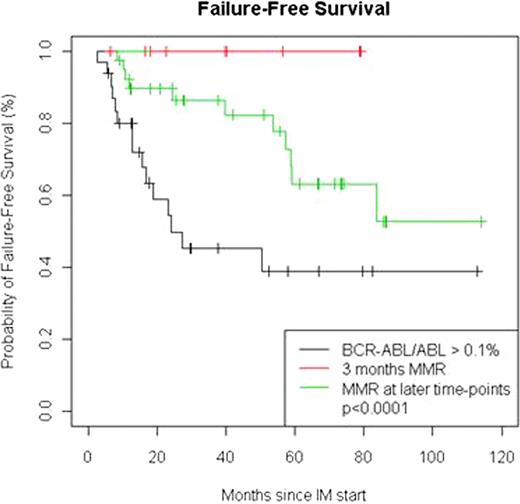Abstract
Abstract 3407
It has been demonstrated that obtaining early complete cytogenetic response (CCyR) in chronic phase (CP) chronic myeloid leukemia (CML) represents a guarantee for a better long-term outcome on imatinib 400 mg/day (IM400) (D. Marin et al. Blood 2008; 112: 4437). Very recently, the introduction in the therapeutic arsenal of second generation tyrosine kinase inhibitors (TKI2) as front-line therapy for CP CML has provided very high and early CCyR rates (~80% at 12 months) that might erase the prognostic value of this last endpoint.
We analysed in a retrospective single center study the impact of early major molecular response (MMR) rates to see whether or not the early achievement of MMR on TKI (here IM400) front-line represents a favourable prognostic factor on outcome. All patients (n=83) were de novo CP CML, treated with IM 400 as single therapy since diagnosis and assessed for their cytogenetic and molecular responses (RQ-PCR for BCR-ABL, expressed as BCR-ABL/ABL ratios (IS) in %) centrally. Failure to IM was defined as progression to accelerated phase or blast crisis, death, loss of CHR, loss of CCyR, confirmed loss of MMR, discontinuation of IM because unacceptable toxicity, primary cytogenetic resistance to IM. The definition of progression included the same variables except the last two. Patients were considered in MMR with a BCR-ABL/ABL ratio ≤0.1% (IS).
There were 47 males (56%) and 36 females with a median age of 53 years (17-82.5) at diagnosis. Three patients (3.5%) had isolated additional clonal abnormalities (ACA) at diagnosis, 4 had a variant Ph 1 and 3 had a masked Ph 1. Two patients (2.5%) had atypical BCR-ABL transcripts (one e1a2 and one a TEL(ETV6)-ABL transcript). Sokal scores were low for 20 (25%), intermediate for 39 (49%) and high for 21 (26%) (3 NA), and Hasford scores were low for 27 (34%), intermediate for 47 (59%) and high for 6 (7%) (3 NA). The median time between diagnosis and IM400 start was 27 days (0-257) and the median follow-up was 41 months (6-116). Twelve percent of patients achieved MMR at 3 months (M3), 31% at M6, 49% at M12, 65% at M18 and 89% at latest follow-up. Three patients died all from BC, none being in the M3 MMR group. Early (M3) MMR was not dependent on Sokal or Hasford scores (p=0.21 and p=0.63 respectively). Multivariate analysis on progression-free survival (PFS) for M3 MMR did not detect any significant parameter including age, gender, prognostic scores, ACA, type of transcript, delay between diagnosis and IM400 start. The PFS was 100% for M3 MMR patients vs 77% (64.2-92.8) for the others (p<0.001). At 5 years, the cumulative incidence of progression was 0% for M3 MMR vs 14% for the others (p<0.001); none of the M3 MMR patients switched to second generation TKIs (TKI2) whereas 27% of other patients did so for resistance (n=7) or intolerance (n=8) or other reasons (n=4). Taking the non-MMR patients as a reference, the failure-free survival (FFS) was 100% for M3 MMR patients any time (p<0.001) vs 63% (47-86) at 5 years for M6→18 MMR patients (HR=0.34, 95%CI=0.16-0.75, p=0.007), with an overall p value <0.001, see figure 1 below.
In conclusion, this study suggests that the achievement of early time-point MMR (i. e. at 3 months) represents a major prognostic factor for progression-free and failure-free survival in CP CML patients on IM400 and its prognostic significance remains to be evaluated in the same population under TKI2 as front-line therapy.
No relevant conflicts of interest to declare.
Author notes
Asterisk with author names denotes non-ASH members.


This feature is available to Subscribers Only
Sign In or Create an Account Close Modal